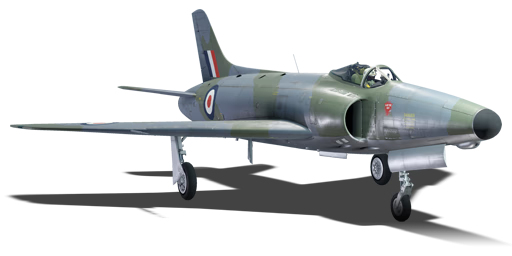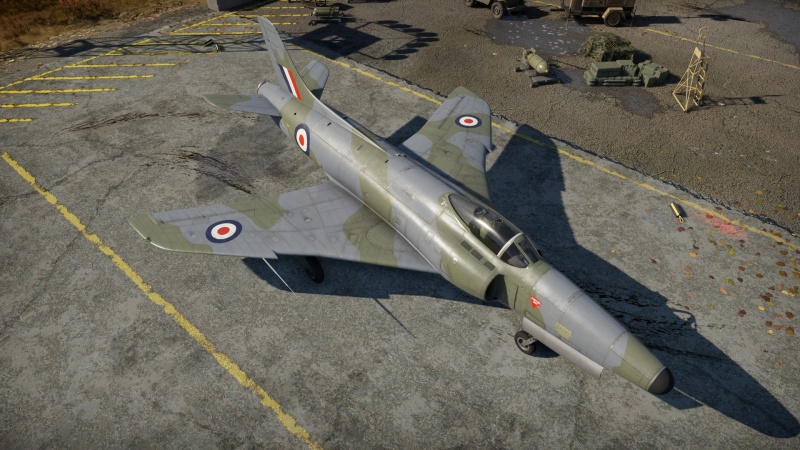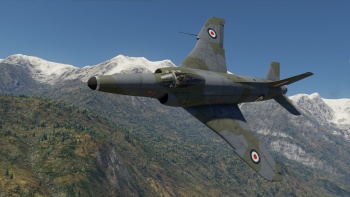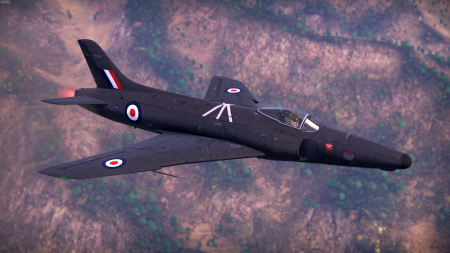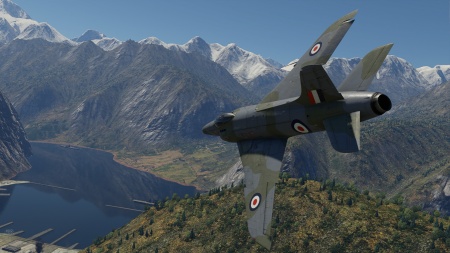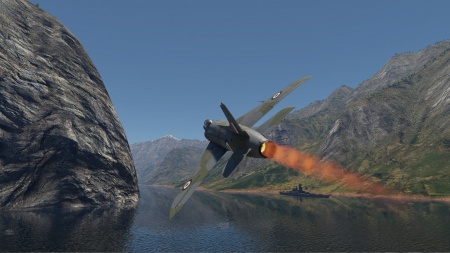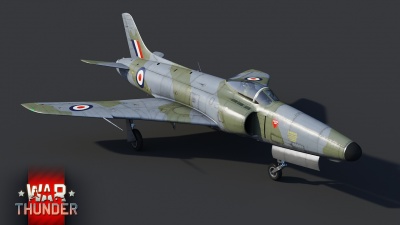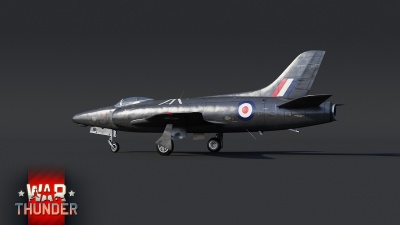Swift F.7
| This page is about the British jet fighter Swift F.7. For the other version, see Swift F.1. |
Contents
Description
The Swift F.7 is a rank V British jet fighter with a battle rating of 8.7 (AB/RB/SB). It was introduced in Update 1.91 "Night Vision".
The Swift F.7 was the last variant in the line of Swift fighters produced by Supermarine Aviation Works. This fighter was one of Britain's fighters to come out of the early 1950s. Post-war England saw new leadership which made the faulty assumption that for the next ten years or so, no new major conflict would happen and therefore defence spending, research and development on new aircraft was reduced to a trickle, mostly experimental prototypes made for research purposes.
The early 1950s saw a change of leadership and Winston Churchill made sweeping changes which amped up research and development churning out Swift fighters as part of that. In the haste to research, develop and produce these fighters, problems crept up in the aircraft which happened so fast, it was difficult to stop the manufacturing process long enough to make the necessary updates, especially problems found during flight trials. These updates when made produced the different Swift variants which lead to the final production of the Swift F.7. By now a majority of the problems with the aircraft had been ironed out, however, the F.7 never entered active service, instead, the fourteen built acted as training aircraft which taught pilots how to get used to shooting off air-to-air missiles, namely the Fireflash.
Though never seeing combat during its short career, the Swift F.7 has an opportunity to make a name for itself in War Thunder. Not as fancy or bristling with weapons like a Sabre or a MiG, the Swift F.7 has its place in the sky and can dance with the best, and even shoot them down. Armed with two 30 mm ADEN cannons and two Fireflash air-to-air missiles, while maintaining between 700 and 810 km/h, this fighter can get the best of even superior aircraft it may go against. Its slower speeds may allow for an overshoot of an enemy aircraft which may place it in front of the Swift's gun sights or even for the radar beam riding Fireflash, of which the enemy pilot will have no indication it was launched unless they are diligent about watching behind them. In the right hands, the Swift F.7 and its weapons have the ability to humble enemy pilots and their superior aircraft.
General info
Flight performance
The Swift F.7 is a good fighter which excels in playing the interceptor role, however like the three bears from Goldilocks' story; this jet has a sweet spot in speed where it does well. Like many jets, this one does not do so well when slow and it becomes an easy target for others to attack. On the other hand, flying too fast causes the controls to lock up, preventing any real manoeuvring at all and, if playing in realistic or simulator battles, ripping off the wing-tips is a very real problem when moving too fast.
The sweet spot or "just right" speed zone for the Swift F.7 is between 700 km/h and 810 km/h. Here the jet will have sufficient speed to properly manoeuvre. Diving either to shoot down another aircraft or to get away from someone on your tail can be a challenge as doing so can result in the aircraft superseding the 810 km/h threshold (easily going into the mid 900s) and end up a sitting duck unable to manoeuvre or if close enough to the ground turning into a lawn dart because it could not pull up due to the control surfaces locking up.
Speed management is key to survival - the afterburner can aid with increasing the aircraft's speed if slow - and with the afterburner the aircraft has a really good climb rate - it can accelerate significantly even in a steep climb. However, slowing down to keep from going too fast is a major problem because this aircraft does not have an air brake and just reducing the throttle will not help very much. Two options are available to reduce speed in this aircraft and the first is to deploy landing flaps. The landing flaps have been reinforced and should not rip when used to slow the aircraft down and can be deployed and retracted as needed. Another option to help bleed off any unnecessary speed is to lift the nose of the aircraft (pull up or back on the control stick). Placing the fighter into a nose-high attitude will help with decreasing speed to a safe zone when the pilot can resume normal flight.
| Characteristics | Max Speed (km/h at 3,048 m) |
Max altitude (metres) |
Turn time (seconds) |
Rate of climb (metres/second) |
Take-off run (metres) | |||
|---|---|---|---|---|---|---|---|---|
| AB | RB | AB | RB | AB | RB | |||
| Stock | 980 | 977 | 12192 | 26.5 | 26.9 | 14.8 | 10.1 | 850 |
| Upgraded | 993 | 985 | 24.1 | 25.0 | 42.6 | 28.0 | ||
Details
| Features | |||||
|---|---|---|---|---|---|
| Combat flaps | Take-off flaps | Landing flaps | Air brakes | Arrestor gear | Drogue chute |
| X | ✓ | ✓ | X | X | X |
| Limits | ||||||
|---|---|---|---|---|---|---|
| Wings (km/h) | Gear (km/h) | Flaps (km/h) | Max Static G | |||
| Combat | Take-off | Landing | + | - | ||
| 0 | 435 | N/A | 1,035 | 465 | ~9 | ~5 |
| Optimal velocities (km/h) | |||
|---|---|---|---|
| Ailerons | Rudder | Elevators | Radiator |
| < 850 | < 600 | < 600 | N/A |
Engine performance
| Engine | Aircraft mass | |||||
|---|---|---|---|---|---|---|
| Engine name | Number | Basic mass | Wing loading (full fuel) | |||
| Rolls-Royce Avon Mk.116 | 1 | 6,639 kg | 276 kg/m2 | |||
| Engine characteristics | Mass with fuel (no weapons load) | Max Takeoff Weight | ||||
| Weight (each) | Type | 7m fuel | 20m fuel | 26m fuel | ||
| 1,000 kg | Afterburning axial-flow turbojet | 7,213 kg | 8,089 kg | 8,553 kg | 9,530 kg | |
| Maximum engine thrust @ 0 m (RB/SB) | Thrust to weight ratio @ 0 m (WEP) | |||||
| Condition | 100% | WEP | 7m fuel | 20m fuel | 26m fuel | MTOW |
| Stationary | 3,126 kgf | 4,501 kgf | 0.62 | 0.56 | 0.53 | 0.47 |
| Optimal | 3,158 kgf (1,167 km/h) |
4,548 kgf (1,167 km/h) |
0.63 | 0.56 | 0.53 | 0.48 |
Survivability and armour
- Armour
- 12.7 mm steel plate behind pilot's seat
- 50 mm bulletproof glass in canopy windscreen
The simple armour setup on this fighter affords protection to the pilot, via the front windscreen having 50 mm bulletproof glass to help protect against head-on attacks. Behind the pilot's seat is a 12.7 mm steel plate which is in place to provide protection for the pilot if their aircraft is shot from behind. The fuel tanks and the engine should take most of the brunt of an attack from behind, but in the event, something gets through the steel plate is meant to be the last line of protection.
Modifications and economy
Armaments
Offensive armament
The Swift F.7 is armed with:
- 2 x 30 mm ADEN cannons, belly-mounted at right side (135 + 185 = 320 total)
This aircraft has been outfitted with two 30 mm ADEN autocannons. Though they are mounted on the fuselage resulting in not having to configure for convergence the pilot will need to account for both autocannons being mounted on the right side of the aircraft fuselage near the right air intake. Pilots which are used to having balanced machine guns or autocannons (equal amounts on both left and right side) will need to slightly adjust their aim to ensure the bullets don't miss just to the side of where they would normally aim. The ADEN cannons when they do hit their mark usually result in a critical hit or a destroyed aircraft with wings flying in one direction and tail sections going in another.
Suspended armament
The Swift F.7 can be outfitted with the following ordnance:
- Without load
- 2 x Fireflash missiles
The Fireflash missile was the first air-to-air guided missile put into service with the United Kingdom's Royal Air Force. Built by Fairey Aviation, the same company who built the Swordfish, this missile utilised radar beam riding guidance to get the missile onto a target. The odd-looking missile consists of a central dart attached to two boosters. The boosters spin-stabilize the missile in flight and propel the missile to speeds upwards of Mach 2. 1.5 seconds after launch, with fuel spent, the boosters separate and the missile would coast the rest of the way to the target, still receiving guidance from the controlling aircraft.
This missile has an effective range of about 4 km (2.4 mi) before it no longer has the kinetic energy to continue. This missile is best used in short-range encounters such as head-on attacks where the enemy fighter is closing the distance rather than flying away. This missile can be used during tail chases as long as you maintain close distance and can keep the radar on the enemy long enough for the missile to acquire its target. The Fireflash is a finicky missile which requires practice and patience, though not as simple to use as other missiles found in-game, it can be a surprise to enemy fighters they are not expecting resulting in them having to go back and watching replays in unbelief to see what took them out. Having only two of these missiles to rely on will require the pilot to exercise restraint and not launch one if the chances of a hit are marginal and instead maybe turn to the 30 mm cannons instead in that instance.
| Unlike heat-seeking missiles, beam riding missiles will not trigger a missile launch warning for the enemy player. |
Usage in battles
The Swift F.7 is played similar to the Hunter as more of a Boom and Zoom aircraft, though it retains dogfighting capability, especially when making use of take-off flaps. The aircraft has a sweet spot for its manoeuvrability around 600-800 km/h. Above those speeds, sustaining a hard turn (or alternatively turning and rolling simultaneously) can result in a ripped wing. It is generally advised to keep some altitude with the aircraft. The missiles are SACLOS-guided and can be useful in head-on. The vehicle has an afterburner which results in higher acceleration than most jets that you will face, though opponents such as the Shenyang F-5 and AV-8A Harrier are capable of accelerating faster. It is recommended to use either 20 minutes of fuel or full tank as 7 minutes does not allow for prolonged use of the afterburner, nor does it allow for loitering.
The Swift F.7 is capable of maintaining a 960 km/h climb at a pitch of 15°, allowing it to achieve altitude of 4 to 5 km easily while maintaining a high speed and catching climbing opponents off-guard. It performs excellently in the support role, where it can Boom and Zoom pre-occupied enemies or maintain a very high speed of over 1,000 km/h in level flight, making gentle turns and passes on opponents who are pre-occupied and being put into vulnerable positions by allied aircraft.
Alternatively the Swift F.7 can be played more aggressively, making use of its energy retention and high thrust-to-weight to engage and wear down enemy fighters. Its take-off flaps can be used as air brakes due to their high rip speed and allow it to manoeuvre at high angles of attack, helping to get guns on target in one-on-one engagements at lower speeds, though it is not recommended to use them excessively nor rate fight due to the speed that will be bled. It is important to note that usage of the take-off flaps at over ~850 km/h will counter-intuitively reduce the turning rate of the aircraft, so they should not be used to manoeuvre on target in high speed dives and passes.
When in a compromised position against a more manoeuvrable aircraft the priority should be to gain separation with the enemy. This can be done against most opponents by accelerating to high speeds using the afterburner, as you can maintain a higher speed in level flight than most aircraft you will face - the Swift F.7 is capable of reaching 1,100 km/h in level flight at sea level while making use of the afterburner. Once separation has been achieved you can make use of your higher energy state and speed to gain some altitude and re-engage on your terms.
Radars
The Swift F.7 is equipped with an AN/APG-30 rangefinding radar, located in the nose of the aircraft. It will automatically detect other planes within the scanning area and display the range to the closest target. It is linked with a gyro gunsight and can help with aiming at close range.
| AN/APG-30 - Rangefinding radar | |||
|---|---|---|---|
| Maximum Tracking Range |
Minimum Tracking Range |
Azimuth Tracking Angle |
Elevation Tracking Angle |
| 2,750 m | 300 m | ±9° | ±9° |
Pros and cons
Pros:
- Superb flight performance thanks to the afterburner; retains energy very well in turns
- Access to excellent Fireflash short-range beam guided missiles, that work against light tanks and helicopters in Ground Realistic Battles
- Equipped with Two powerful 30 mm ADEN autocannons
- Fireflash can be considered as all-aspect missiles; unfazed by flares and equipped with a proximity fuse
- Flaps and wings have a very high rip speed limit
- Can withstand some damage from 7.62 mm and .50 cal rounds
- Afterburner takes about 8-15 minutes of continuous use to cause engine overheating
Cons:
- No dedicated airbrake, must use take-off flaps as an airbrake at high speeds
- Both autocannons are on right side of the aircraft fuselage, requires slight adjustment when aiming
- Fireflash missiles have to be manually guided; 2 Gs overload limits the performance
- Poor manoeuvrability at high speeds (> 950 km/h) and high risk of ripping wings while pulling Gs
- Less ammunition for 30 mm ADEN than the F.1 variant; requires trigger discipline
History
In the years following the end of WW2, Great Britain focused their efforts on rebuilding their nation from the devastation caused by the war as the British government didn't consider a new war possible in the following ten years. Under these circumstances, developing new military technology wasn't considered a priority in most cases.
As a result, Great Britain found itself lagging behind in military aviation at the start of the 1950s by the outbreak of the Korean War. This prompted the RAF to hastily look for a new fighter aircraft to put into service, even if it meant taking into consideration an interim design.
One of the designs that sparked the RAF's interest was a new swept-wing aircraft developed by the Supermarine company - the Type 510. Being in essence just a modified Supermarine Attacker, development of this design continued, eventually maturing into the Type 541.
Soon, the Type 541 received the highest development priority and was hastily rushed through testing and into production as the Supermarine Swift. In fact, production was so rushed that it began before necessary design changes could even be applied from the results of the test flights conducted with the Type 541 prototypes.
Nonetheless, the Supermarine Swift F.1 entered service with the RAF in February 1954, followed shortly afterwards by the F.2 variant. However, many of the aircraft's teething problems weren't resolved as a result of being rushed into production. This resulted in a number of accidents happening early on involving the Swift , leading to the aircraft being grounded for a time.
Newer modifications were developed, which addressed most of the known issues. However, it was a case of too little too late for the Swift, as it quickly became replaced by the Hawker Hunter. In the end, just under 200 Supermarine Swifts were produced out of the close to 500 planned aircraft. The Swift was phased out of active service relatively quickly after its introduction, with the last fighter models being withdrawn by the RAF in the mid to late 1950s.
- From Devblog
Media
- Skins
- Images
- Videos
See also
- Related development
- Supermarine Attacker FB 1
- Supermarine Attacker FB.2
- Aircraft of comparable role, configuration and era
- North American F-86 Sabre
- Dassault M.D.450B Ouragan
- de Havilland Venom
- Grumman F9F Cougar
- Hawker Hunter
- Mikoyan-Gurevich MiG-17
- Saab J29D Tunnan
External links
- [Development] Supermarine Swift: Banking on Success
- Official data sheet - more details about the performance
| Supermarine | |
|---|---|
| Spitfires | |
| Merlin engine | Spitfire Mk Ia · Spitfire Mk IIa · Spitfire Mk.IIa Venture I · Spitfire Mk IIb |
| Spitfire Mk Vb · Spitfire Mk Vb/trop · Spitfire Mk Vc · Spitfire Mk Vc/trop | |
| Spitfire F Mk IX · Spitfire F Mk IXc · Spitfire F Mk XVI | |
| Spitfire LF Mk IX · Plagis' Spitfire LF Mk IXc | |
| Griffon engine | Spitfire F Mk XIVc · Spitfire F Mk XIVe · Prendergast's Spitfire FR Mk XIVe · Spitfire F Mk XVIIIe · Spitfire F Mk 22 · Spitfire F Mk 24 |
| Export | ▄Spitfire Mk Vb/trop · ▃Spitfire LF Mk IXc · ▂Spitfire Mk IXc · Spitfire Mk IXc · Spitfire Mk.IX (CW) · Weizman's Spitfire LF Mk.IXe · ▄Spitfire FR Mk XIVe |
| Seafires | Seafire LF Mk.III · Seafire F Mk XVII · Seafire FR 47 |
| Export | ▄Seafire LF Mk.III |
| Jet fighters | Attacker FB 1 · Attacker FB.2 · Scimitar F Mk.1 · Swift F.1 · Swift F.7 |
| Hydroplanes | Walrus Mk.I |
| Britain jet aircraft | |
|---|---|
| Blackburn | Buccaneer S.1 · Buccaneer S.2 · Buccaneer S.2B |
| British Aerospace | Harrier GR.7 · Sea Harrier FRS.1 (e) · Sea Harrier FRS.1 · Sea Harrier FA 2 |
| British Aircraft Corporation | Strikemaster Mk.88 |
| English Electric | Canberra B Mk 2 · Canberra B (I) Mk 6 · Lightning F.6 · Lightning F.53 |
| Gloster | Meteor F Mk 3 · Sea Meteor F Mk 3 · Meteor F Mk 4 G.41F · Meteor F Mk 4 G.41G · Meteor F Mk 8 G.41K · Meteor F Mk.8 Reaper |
| Javelin F.(A.W.) Mk.9 | |
| de Havilland | Vampire F.B.5 · Venom FB.4 · Sea Venom FAW 20 · Sea Vixen F.A.W. Mk.2 |
| Hawker | Sea Hawk FGA.6 · Hunter F.1 · Hunter F.6 · Hunter FGA.9 · Harrier GR.1 · Harrier GR.3 |
| Panavia | Tornado GR.1 · Tornado GR.4 · Tornado F.3 · Tornado F.3 Late |
| SEPECAT | Jaguar GR.1 · Jaguar GR.1A · Jaguar IS |
| Supermarine | Attacker FB 1 · Attacker FB.2 · Scimitar F Mk.1 · Swift F.1 · Swift F.7 |
| Foreign | Phantom FG.1 (USA) · Phantom FGR.2 (USA) · F-4J(UK) Phantom II (USA) |
| Australia | F-111C |
| India | ▄MiG-21 Bison |
| South Africa | ▄JAS39C |


